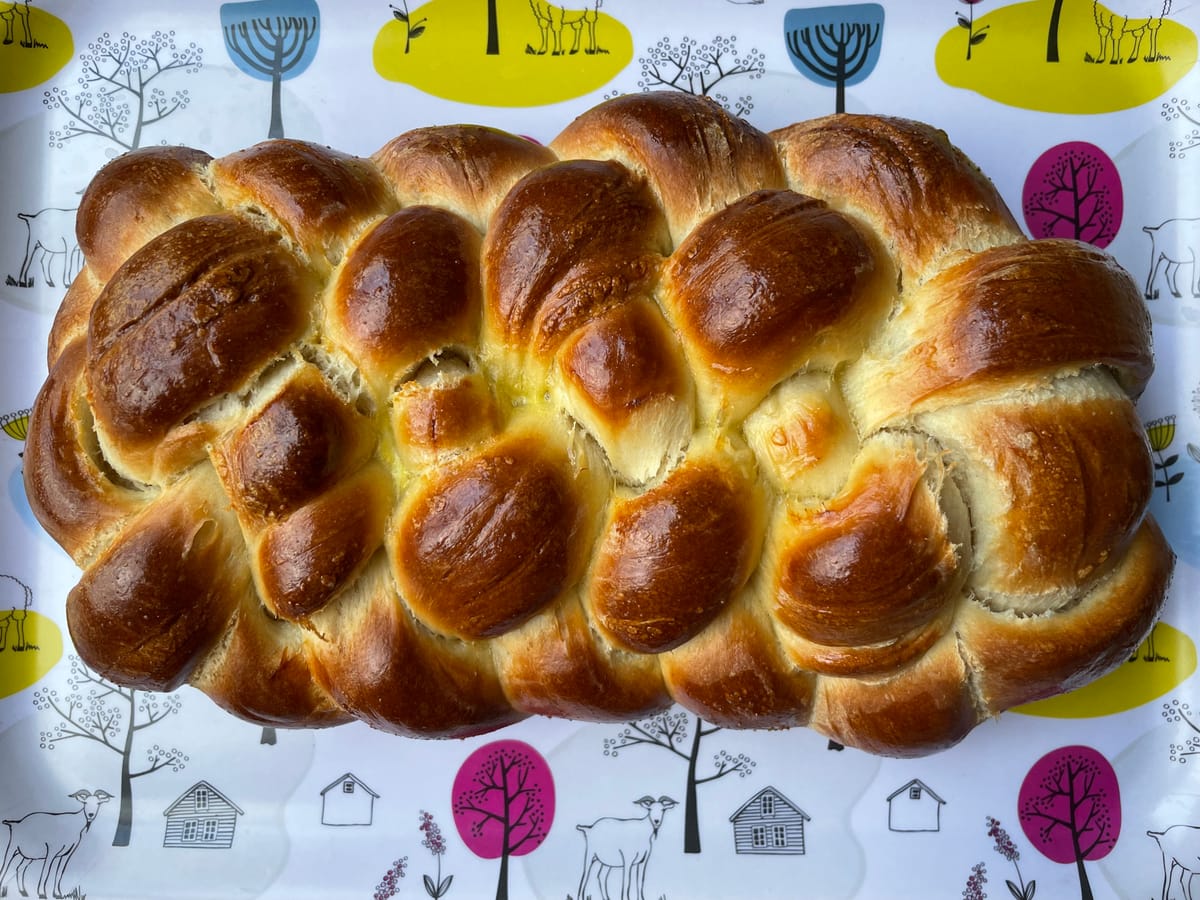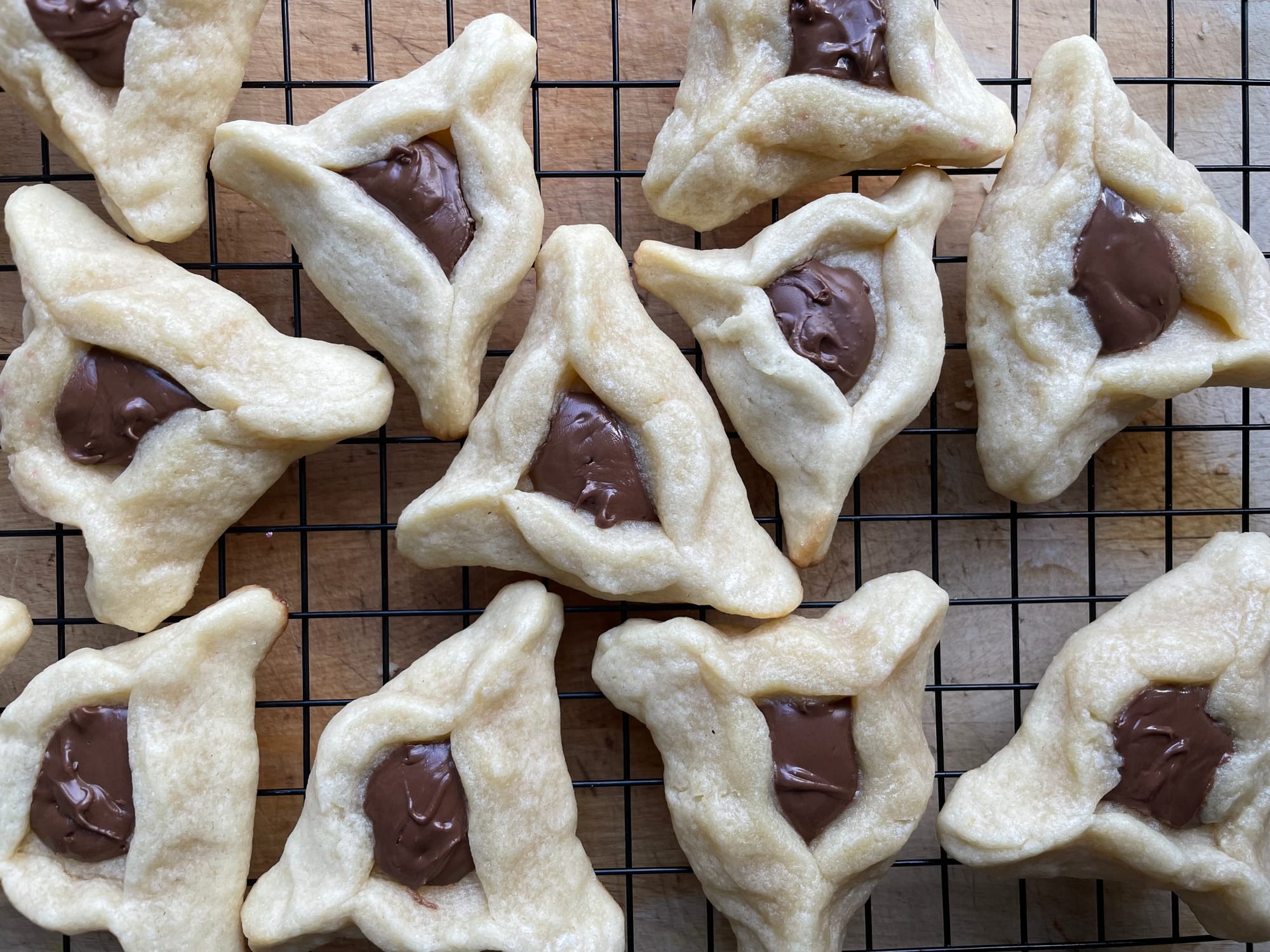Hamantaschen, challah, and the joy of baking Jewishly

There are plenty of serious, spiritual reasons that I converted to Judaism: my need for religious ritual, the appeal of a millennia-long tradition, the egalitarian and progressive values, the way that grappling with the divine and never quite finding a definitive answer is not only tolerated but encouraged.
But there's another reason, one of those things that you can toss off in a jokey way that obscures how powerful it actually is: one of the things I love about being Jewish is that it gives me an excuse to bake more.
Minnesota's Jewish population is small—approximately 65,900 people, which is just over one percent of the state's total population. Since nearly all of us live in the Twin Cities metro, there are a few businesses that specialize in Jewish baked goods and groceries (shout out to Cecil's Delicatessen in St. Paul and The Kosher Spot in St. Louis Park). There are also several spots that sell challah on Fridays as well as bakeries and cottage food producers who offer holiday items, like sufganiyot for Hanukkah or flourless tortes for Passover. However, none of those Jewish-oriented businesses are close to my home—I can't pick up a loaf of challah at my local grocery store or get a dozen hamantaschen for Purim from the nearest bakery. If I want to eat Jewish baked goods, the easiest thing way to do it is to make them myself.
I love baking (the name of this newsletter/blog is a baking reference) so this isn't exactly a hardship. Plus, baking Jewishly is also a way for me to connect to Jewish culture. As a recent convert, there are many Jewish spaces and rituals that feel unfamiliar to me, but baking is something that makes me feel comfortable and confident. Was I consumed by social anxiety and Jewish imposter syndrome as I prepared to attend my congregation's Hanukkah party? Yes! Did baking a bunch of blue-hued crinkle cookies to bring along for the potluck help? Kind of!
Baking has also been entry point into holidays that I was completely unfamiliar with prior to converting, like Purim. (Quick Purim rundown: it's a spring holiday that commemorates Jewish survival in diaspora, and it's celebrated by reading the Book of Esther, giving gifts of food, donating to those in need, and enjoying a festive meal, which often includes hamantaschen, triangular-shaped filled cookies.) Similar to Hanukkah, celebrating Purim for the first time felt a bit intimidating—I didn't have any memories or family traditions to draw upon, and my synagogue didn't offer any organized events. Baking hamantaschen felt manageable, and I spent at least a month deciding which flavor to make—traditional poppy seed or a more modern variation like Nutella? I even took a "Which Hamantaschen Are You?" quiz, and in a surprise to no one who knows me, the answer was chocolate.
I ended up using this hamantaschen recipe from The Nosher, my go-to source for Jewish recipes. I filled most of them with Nutella and a couple of them with chocolate chips for my sister, who's allergic to hazelnuts. Making the dough went smoothly, and my hamantaschen looked fine when they went into the oven, each round of dough pinched into a triangular shape around the filling. Seven minutes later, the end results were a far cry from the perfect hamantaschen depicted on the recipe. To be honest, several of them were candidates for the Ugly Hamentashen Instagram account. I think I should've rolled out the dough a little bit thinner—lesson learned for next Purim's batch of hamantaschen.

Nevertheless, the hamantaschen tasted great, tender and buttery with just a hint of vanilla. I gave a half-dozen to my sister and her family and a few to Josh, to fulfill my Purim gift-giving obligation and also because I really like giving baked goods to people. It's wonderful to celebrate Jewish holidays in community—I'm already looking forward to my synagogue's Passover seder—but there is also something joyful about celebrating Jewish holidays with my non-Jewish loved ones, and explaining why, exactly, I've just handed them with a bag of oddly-shaped cookies. Many discussions about the benefits of religion focus on the serious stuff, like how it can provide a sense of meaning or an ethical code. Perhaps just as important are the smaller moments of happiness, like biting into a hamantasch fresh from the oven or commiserating with fellow bakers about your misshapen cookies.
Outside of the holidays, Jewish baking traditions add joy to my Shabbat observance. I don't bake challah every week—my goal is once per month—but when I do, it's deeply meaningful. Challah isn't just a tasty loaf to enjoy with Shabbat dinner; it's also part of the Shabbat ritual, with its own dedicated prayer.
It is profoundly empowering to make a ritual object myself. When I was a practicing Catholic, worship was a spectator sport: I went to Mass and listened and stood up and kneeled on cue, occasionally reciting scripted responses. There are some home-based rituals in Catholicism; for example, I grew up in a household where we said grace before supper. But the chicken tacos on the table didn't have any specific ritual significance, they were just what happened to be for dinner that night.
In contrast, home-based rituals such as Shabbat dinner are far more central to Jewish practice, and challah is rich with symbolism and tradition. The intertwined strands of dough symbolize love, and a three-stranded braid stands for truth, peace, and justice. Round loaves are baked for Rosh Hashanah (the Jewish New Year) to symbolize continuity, and ingredients like poppy and sesame seeds, honey, and raisins also have specific meanings.
When I bake challah, I have to organize my whole Friday afternoon around it, in a way that makes me very conscious of my Jewishness. I'm fortunate to work at home, so I can mix and knead the dough at the end of my lunch break, take a break to braid my loaf in the mid-afternoon, and then start baking it just before dinner, so we can enjoy challah fresh from the oven.
I once read that braiding hasn't been automated, so every loaf of challah is braided by hand. I have no idea if that's true, and I don't want to research it—I'm too attached to the idea that every single loaf of challah was, is, and will be hand-braided. I like to do a six-stranded braid, the strands weaving over and under and over and under and finally over again, forming a wide plait of dough. I like thinking about all the other Jews simultaneously making challah for their Shabbat dinners, and the challah bakers who came before me and the challah bakers yet to come. I like the fact that I am engaging in an intentional religious practice, instead of passively nodding along. I like saying the blessing and pulling apart the challah and eating it by the flickering light of Shabbat candles. I like knowing that if I want to, I get to do it all over again next Friday, and the Friday after that, a reassuring, ritualistic rhythm.
There are many aspects of Judaism that I struggle with. There's so much to learn, and so much cultural context that I haven't yet absorbed. Repairing the world (tikkun olam) feels nigh on impossible after perusing the day's headlines. Being a righteous person—a truly righteous person, not just being polite to cashiers and recycling—is the work of a lifetime.
But baking Jewishly? That's something in which I can always find meaning, and something that I can always get right.